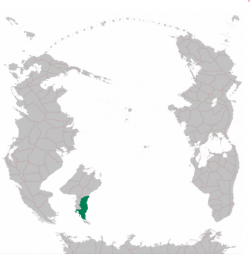Alterra (Pacifica)
Commonwealth of Alterra Commonwealth of Alterra | |
|---|---|
|
Flag | |
Anthem: O Alterra | |
 Location of Alterra in Pacfica | |
| Location | Central Crabry, bordered by Esfalsa to the west and Phanama to the north, |
| Capital and largest city | Alterra City |
| Official languages | Austral, Alman (unrecognized) |
| Demonym(s) | Alterran |
| Government | Federal constitutional democratic republic |
| Thomas Anderson | |
| Laura Clarke | |
| James Addington | |
| Alan Jones | |
| Legislature | Federal Congress |
| Federal Senate | |
| Federal Council | |
| Formation | |
• Commonwealth of Alterra | 19 February 1920 |
| Population | |
• 2021 census | 29,997,445 (2021) |
| GDP (nominal) | estimate |
• Total | $796.5 billion |
| Currency | Alterran Altair (ALT) |
| Time zone | UTC-1 (CCT) |
| Date format | dd/mm/yyyy |
| Driving side | right |
| Calling code | +19 |
| World Forum Code | AT |
| Internet TLD | .at |
Alterra, officially the Commonwealth of Alterra, is a federal state in central Crabry bordered by Esfalsa in the west and Phanama in the north. Having a population of around 29 million people (2020), Alterra is a relatively open populated country, with 396 people per square kilometer. The country's population is centered around the country's major cities, namely Alterra City and Astria.
Alterra is a country composed of 25 different formerly independent city-states which united under one banner, that being the Commonwealth of Alterra, in February of 1920 during the signing of the Treaty of Alterra.
The city of Alterra City is the administrative and economic capital of the Commonwealth, and also serves as the seat of the Alterran Federal Congress, the country's legislative branch, and the nation's largest city, with over 3.1 million people calling the city home. The country's second largest city, Astria City, is home to over 1.5 million people and has for the past three decades been racing with the national capital to become Alterra's economic base.
The Commonwealth of Alterra is a newly-approved member of the World Forum, having joined in October of 2021, and is also a full member state of the Cross Pacific Space Cooperation organization.
Etymology
The name Alterra originated from the last name of the nation's founding figure and first president, Benjamin Alterra. The country, paying respect to the efforts made by the first president and his Group of Ten, an informal group of men and women who contributed significantly to the establishment of the Commonwealth on February 19, 1920, named the new nation after its founding figure and first president on February 14, 1920.
Geography
Location and borders
The total land area of Alterra as of October of 2021 stands at 75 704 km^2, making it a relatively small yet quite open country in terms of population density. The country borders Esfalsa and Phanama to the west and north respectively.
The country is divided into twenty-five (25) provinces, each of which directly resemble the tribe or city-state which once stood independent on its very territory over a hundred years prior. Beyond that, it is also divided into fifty (50) municipalities, which are considered subordinate administratively to the higher twenty-five provinces of the Commonwealth.
Geology, topography and hydrography
Climate
Flora and Fauna
Natural Conservation Areas
Urban Areas
Demographics
History
Politics
Government
The Government of Alterra is the national administrative body wielding supreme executive authority over the sovereign state of the Commonwealth of Alterra.
Organisation and formation of the government
The Alterran Government operates as a three-branch collegial body with collective responsibility, and consists of the executive branch led by the President of the Commonwealth, who is appointed and/or dismissed by a popular vote held every four years during a presidential elections. The executive branch also includes the Presidential Cabinet, which is composed of the various departmental secretaries of the Government. The Cabinet is appointed and dismissed by the President with the approval of the Federal Senate. The legislative branch is composed of the Federal Congress, which is divided into the Federal Senate and the Federal Council, which are the upper and lower houses respectively. Thirdly, the Judicial branch is led by the Supreme Court Justice and is composed of the Supreme Court, which is above the subordinate Municipal, Provincial and National Courts.
